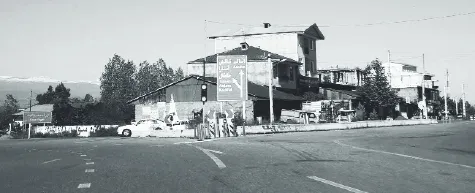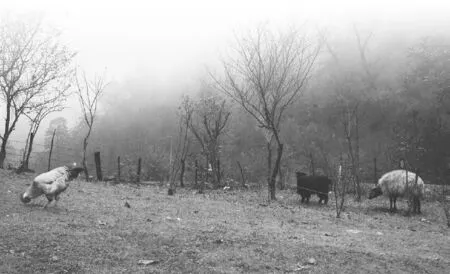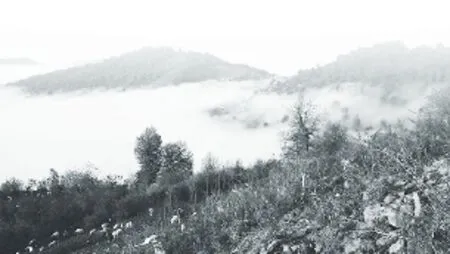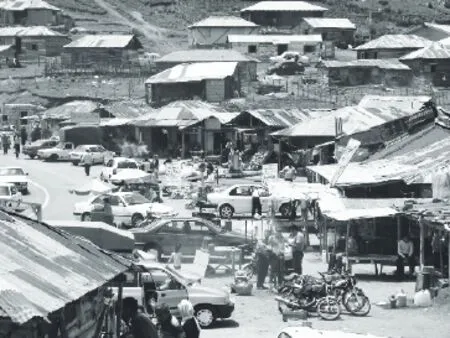消逝的天堂:哈勒哈勒—阿塞伦路上的风光
by Tehran Bureau
Cass 译
消逝的天堂:哈勒哈勒—阿塞伦路上的风光
A Vanishing Paradise:1)Along Iran’s Khalkhal-2)Asalem Road
by Tehran Bureau
Cass 译

现代化的发展往往意味着对美丽自然风光以及古老传统文化的破坏。在伊朗的哈勒哈勒—阿塞伦路上,沿途的美丽风光正在日渐消亡,传统木屋变成了混凝土房子,美丽的稻田变成了度假村别墅,村民们的生活方式也被迫改变……


1) Khalkhal 哈勒哈勒市,位于伊朗西北部,居民大多是阿塞拜疆族
2) Asalem 阿塞伦市,位于伊朗吉兰省
On a recent day in Loomavesht, a village up the Khalkal-Asalem road in north Iran’s Gilan province, the men sheer sheep and the women clean the wool. A cool mist fills the air, and soon the cold weather will drive most of the villagers and their livestock down the Alborz mountains to live out the winter. During yehlagh, the old Persian name for the warm season, shepherds live here in small huts set into the rolling slopes like mushrooms, but3)newfangled vacation villas tell of an approaching development boom. Up the hill, the foundations of a concrete compound commissioned by an Isfahan businessman jut out of the ground at right angles.
前不久的一天,在洛玛夫什—位于伊朗北部吉兰省的哈勒哈勒—阿塞伦路上的一个村庄,男人们驱赶着羊群,女人们清洁着羊毛。寒雾弥漫在空中,不久,严寒的天气就会把村民们和他们的家畜驱赶下阿尔伯兹山脉,以度过这个冬天。在“耶拉弗”期间—古波斯人们这样称呼暖季,牧羊人住在临时搭建在斜坡上的小棚屋,起起伏伏看起来就像是蘑菇一般,但是新奇的度假别墅预示着另一种繁荣发展的景象即将来临。就在山上,受一位伊斯法罕商人所托而建造起来的混凝土建筑地基正和地面呈直角状崛起。
“Show your flms Miss, show them what our village was like before the people of Tehran and Isfahan took over,” a young man tells a flmmaker who has made a series of movies here in the past decade. “Those flms are proof of what this place used to look like.”
“展示一下你的影片,女士,让他们看看我们村子在德黑兰人和伊斯法罕人到来之前是什么样子的,”一个年轻人向一位电影制作人说道,这位电影制作人在过去的十年里拍了一系列影片。“那些影片能证明这个地方以前是什么样子的。”
Miles from the4)Caspian Sea, Loomavesht is sometimes called “heaven on earth” for its5)bucolic charm. Filmmakers like Ali Mohammad Ghassemi, Mehrdad Oskooie and Mohammad Ali Talebi have worked in the area for the past two decades, and it’s from their work that many heard, for the frst time, of the traditional dress worn by the women of Talesh, of the scenic landscapes of the Khalkhal-Asalem trail. But as improved connections to the capital lure visitors to the area, Loomavesht locals are forced to make space for modernity.
里海几英里之外,洛玛夫什因其美丽的田园风光有时会被称为“天上人间”。诸如阿里·穆罕默德·卡西米、迈赫达德·奥斯库伊和穆罕默德·阿里·塔勒比等电影制作人在这个地方工作了二十年,也正是从他们的作品里,很多人第一次听说了塔利什女人所穿的传统裙饰,听说了哈勒哈勒—阿塞伦路上的优美风景。但由于要修缮连接首都的道路以吸引游客,洛玛夫什当地人被迫为现代化腾挪空间。
In Kharjegil, another small village on the Khalkhal-Asalem Road, Amou Nezam’s cabin is famous for Aash Doogh: soup with garlic, doogh, herbs and chickpeas. As a side business, Amou Nezam arranges property purchases for out-oftown visitors. “I had a customer from Tehran ask me about buying property here,” says Amou. “I helped him get a 600 square meter piece of land. Shame on me, I made a big mistake.”
在哈尔杰吉尔,哈勒哈勒—阿塞伦路上的另一个小村庄,阿穆纳扎姆的小木屋因其咸酸奶饮料而闻名—一种加有大蒜、酸奶、香草和鹰嘴豆的饮品。阿穆纳扎姆的副业是帮助外地游客处理房产购置事务。“我有一个从德黑兰来的顾客想在这里购置房产,”阿穆说道。“我帮他买下了一块600平方米的土地。我感到羞愧,我犯了个大错。”


The seaside and mountain villages of north Iran have long been a popular vacation destination for city dwellers escaping the traffc and pollution. The province of Mazandaran, closer to Tehran, has6)morphed into a land of holiday homes. “We were the primary rice producers of the country,” says a shopkeeper from Sari, the capital of Mazandaran. “Then we sold all the rice felds, built villas on top of them. Now, we need to import our rice.”
伊朗北部的海边和山村一直以来都是广受城市居民欢迎的度假胜地,在这里,他们可以远离繁忙的交通和环境污染。毗邻德黑兰的马赞德兰省,已经转变为度假村。“我们是这个国家的主要大米生产者,”一位来自萨里的店主说道,萨里是马赞德兰的省会。“但是我们卖掉了所有的稻田,在稻田上建造别墅。如今,我们的大米需要进口了。”
As we head farther up the road, we reach Loomavesht, then Esbahooni. There were only a few wooden huts here ten years ago, dispersed across the hills. Now, you can see dozens of concrete houses here, displaying Chinese-style red roofs, the contemporary aesthetic of homes across the country.
我们继续往前走,到达洛玛夫什,然后是埃斯巴胡尼。十年前,这里仅有一些小木屋,零星分布在山上。如今,你可以在这儿看到许多混凝土房子,展示着中国式的红屋顶,这代表着当今整个国家对于住宅的审美观。
3) new-fangled [΄njuːˌfæŋɡld] adj. 新奇的,新制的
4) Caspian Sea 里海,世界最大的咸水湖
5) bucolic [bjuː΄kɒlɪk] adj. 牧羊的,牧歌的,田园风味的
6) morph [mɒf] v. 转变,变形
Tourists come to Esbahooni for its kateh(sticky rice) kabob—7)mushy northern rice with lamb kabob and fresh butter. Villagers sell their mutton and dairy to the shopkeepers, who cook the kabob and rice. A decade ago, the village consumed what it produced with little connection to the outside world. Villagers drained their8)sewage into9)cesspits and burned or10)composted their trash. At the restaurants, they used reusable dishes. The arrival of tourists has brought the accompanying culture of consumer goods, but there is no trash collection system in place to respond to it.

游客们为了糯米烤肉串而来到埃斯巴胡尼—软糯的北方大米与烤羊肉串和新鲜的黄油搭配。村民把羊肉和奶制品卖给店主,店主烤肉串和煮米饭。十年前,村民们自给自足,和外界接触甚少。村民们将他们的污水排入污糟,将生活垃圾焚烧或制成堆肥。餐馆里,使用的都是可重复使用的餐具。游客们的到来带来了相应的生活消费品文化,但是却没有与之应对的垃圾收集系统。
In Esbahooni, the hillsides are littered with plastic bags, empty soda bottles and junk food wrappers. Locals and homeowners toss them out and burn whatever they collect in big heaps. On those days, the stink of burning plastic overtakes the cool air.
在埃斯巴胡尼,山坡上都堆满了塑料袋、空汽水瓶和垃圾食品包装袋。本地人和房屋主人扔掉这些垃圾,积聚成堆之后将其焚烧掉。在那些日子里,塑料燃烧的臭味掩盖了清爽的空气。
As we drive further northwest to Astara, Ardabil and through the Arasbaran forest where old villages stand in clusters, we find the same symptoms of urbanization. The region is rich with forest wood, and villagers traditionally built wooden huts with the materials around them. These days, the lumber is shipped to Tehran, often illegally, and the houses are rebuilt with aluminum and concrete. “I miss the old house,” says an auto mechanic in Kharjegil. “It was11)cozy, it was easy to warm...we were told this method is healthier, more modern. Relatives kept telling us to change that old dehati (villager) house.”
我们继续向西北行驶到达阿尔达比勒省的阿斯塔拉市,穿过阿拉斯巴兰森林,那里村庄群集,我们在那里也发现了相同的城市化症状。该地区森林木材资源丰富,传统上,村民会使用周围的材料建造小木屋。如今,木材被运往德黑兰,通常是非法进行的,而村民使用铝和混凝土重建房屋。“我想念旧式房屋,”哈尔杰吉尔的一个汽车修理工说道。“旧房屋舒适保暖……但是有人跟我们说这种方式更健康、更现代化。亲戚们一直劝我们改建旧村屋。”

Astara, farther northwest of Asalem, was once known for seaside houses with wooden windows and12)ceramic roofs. During the13)Ahmadinejad era, the state gave rural residents 8-million-toman loans to refurbish their homes. The villagers tore down their homes, but couldn’t afford a complete reconstruction. As they built their new homes, they sold off chunks of their land to make way for vacation homes. The village homes are now made of aluminum and concrete slabs with no adorning facade, and sit next to luxurious vacation homes with elaborate exteriors.
阿斯塔拉,位于阿塞伦市遥远的西北部,曾因带有木制窗户和陶瓷屋顶的海滨房子而闻名。在阿玛迪内贾德执政时期,国家给农村居民提供了800万托曼贷款,用来翻新房屋。村民们拆毁了自己的家园,但却无法承担完成重建的全部费用。他们为建设新家园出售了大片土地,为建造度假屋腾空间。村里的房屋现在由铝板和混凝土板建成,外观没有任何装饰,就坐落在外部精致的豪华度假屋旁。
I speak to a married couple, who were villa owners and both doctors from Tehran with children in college. “We love this place,” the wife says. “We get away from the smoke, the pollution, the traffc.” When I ask her if she thinks their very presence is ruining the things she cherishes, she shrugs: “If we didn’t buy this land, someone else would.”
我与一对已婚夫妇交谈,他们是别墅业主,两个人都是医生,来自德黑兰,孩子们都在那里上大学。“我们深爱这片土地,”妻子说道。“在这里,我们能免受烟雾、污染和繁忙交通之苦。”当我询问她是否想过他们自己正在毁掉她所珍惜的东西,她耸耸肩:“就算我们不买这土地,其他的人也会买。”
With development comes culture clash: villagers accustomed to hauling lumber with donkeys encounter Porsches in their backyard.“The man and woman showed up and I assumed they were a couple, but now he brings a different woman every week, God forgive,” a Kharjegil farmer complains. He is selling off another parcel of his land to afford the reconstruction of his home.
随着发展而来的是文化冲突:村民们习惯使用驴子拖运木材,却在后院里见到保时捷。“一个男人和女人一起出现,我就认为那是一对夫妇,但是现在他每周都带着另一个不同的女人,上帝,请原谅,”一位哈尔杰吉尔的农民抱怨道。他正准备以低价再卖掉一块地来支付重建家园的费用。
“People from the village sell their property to rent a small apartment in the city. They work in construction, sometimes as laborers on the very lands they sold,” says a Lisar villager who refuses to sell the14)lot he inherited from his father, despite pressure from his family. He tells me of a young man who sold some property, married and moved to Tehran two years ago to work in construction. “They rented a small basement in the south of Tehran. Their bodies were found in the winter. They died of gas poisoning.”
“村民们卖掉自己的房产,跑去城市租一间小公寓。他们在工地工作,有时候还在他们卖出的土地上做劳力,”一位村民这么说道,他拒绝出售从父亲那里继承来的土地,即使顶着来自家人的压力。他告诉我一个年轻人卖了部分房产,两年前结了婚,搬到德黑兰做建筑工人。“他们在德黑兰南部租下一间小地下室。冬天的时候人们发现了他们的尸体,死于煤气中毒。”
7) mushy [΄mʌʃɪ] adj. 糊状的,玉米粥状的
8) sewage [΄sjuːɪdʒ] n. 污水
9) cesspit [΄sespɪt] n. 污水坑
10) compost [΄kɒmpɒst] v. 使成混合肥料
11) cozy [΄kəʊzɪ] adj. 舒适的,安逸的,惬意的
12) ceramic [sɪ΄ræmɪk] adj. 陶器的
13) Ahmadinejad 阿玛迪内贾德,伊朗的第六任总统, 执政时期为2005年至2013年
14) lot [lɒt] n. 一块地

